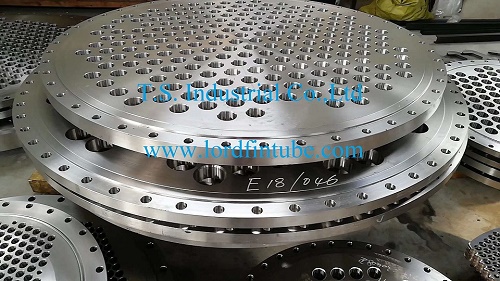The 316L stainless steel tube sheet, made of low-carbon corrosion-resistant alloy, is engineered for high-temperature/pressure and harsh environments, widely used in heat exchangers and pressure vessels for chemical, marine, and energy industries.
1. 316L Stainless Steel Tube Sheet
A 316L stainless tube sheet is a precision-engineered flat plate with drilled holes, designed to secure tubes in industrial equipment such as heat exchangers, boilers, and condensers.
Material Significance: 316L Stainless Steel: An austenitic alloy (UNS S31603) with:
16-18% Chromium (Cr) → Forms passive oxide layer for corrosion resistance.
10-14% Nickel (Ni) → Enhances ductility and toughness.
2-3% Molybdenum (Mo) → Superior resistance to pitting/crevice corrosion (critical for chlorides).
Low Carbon (≤0.03%) → Prevents sensitization during welding.
2. 316L Stainless Steel Tube Sheet Material Properties
Property | 316L Stainless Steel | Advantage |
Corrosion Resistance | Excellent in chlorides (e.g., seawater, acids) | Outperforms 304/304L in harsh environments |
High-Temperature Strength | Stable up to 800°C | Ideal for heat exchangers & boilers |
Mechanical Strength | Tensile: ≥485 MPa, Yield: ≥170 MPa | Withstands high-pressure fluids |
Weldability | Low carbon reduces carbide precipitation | Minimizes post-weld corrosion risk |
3. 316L Stainless Steel Tube Sheet Manufacturing Process
-Step 1: Precision Drilling
- CNC-drilled holes with tight tolerances (±0.1mm).
- Patterns: Triangular/square layouts for optimal fluid flow.
-Step 2: Tube Attachment
-Expansion: Mechanical tube-to-sheet sealing for leak-proof joints.
-Welding: TIG/MIG welding for high-pressure applications. -Step 3: Surface Finishing
- Options: 2B (smooth), BA (bright annealed), or electropolished (for sanitary use).
4. 316L Stainless Steel Tube Sheet Applications & Industry Solutions
Core Industries:
-Chemical Processing: Reactors, heat exchangers (resists sulfuric/phosphoric acids).
-Marine Engineering: Desalination plants, shipboard condensers (anti-saltwater corrosion).
-Energy: Nuclear/petrochemical pressure vessels (ASTM A182 F316L compliance).
-Pharmaceutical: Hygienic tube sheets with Ra≤0.8μm surface finish.
Why Choose 316L?
-Case Example: Shell-and-tube heat exchanger in a coastal power plant:
-Problem: Chloride-induced pitting in 304 tubesheets. -Solution: 316L tubesheet extended service life by 3×.
5. 316L Stainless Steel Tube Sheet Advantages vs. Alternatives
Feature | 316L Tube Sheet | Carbon Steel Tube Sheet |
Corrosion Resistance | ★★★★★ | ★☆☆☆☆ (prone to rust) |
Maintenance Cost | Low (long-term) | High (frequent replacement) |
Lifespan | 15-20+ years | 5-8 years (with coatings) |
6. 316L Stainless Steel Tube Sheet Quality Assurance & Standards
-Certifications: ASTM A240, ASME SB, EN 1.4404.
-Testing:
-Chemical Analysis: Spectrometry to verify Cr/Ni/Mo content.
-Mechanical Tests: Tensile, hardness, bend tests.
-NDT: Dye penetrant (PT) or radiographic (RT) inspection.
7. 316L Stainless Steel Tube Sheet FAQ
Q: Why is 316L preferred over 316 for welded tube sheets?
→A: 316L’s low carbon prevents carbide precipitation in heat-affected zones (HAZ), reducing weld decay risk.
Q: How to prevent tube-to-tubesheet joint failure?
→A: Combine expansion + seal welding for high-vibration environments (e.g., offshore platforms).

Comments
Post a Comment